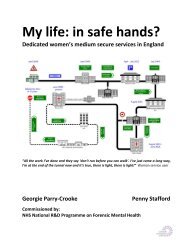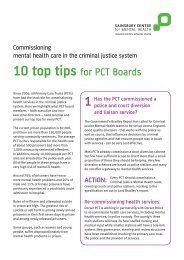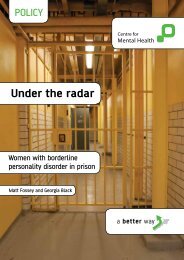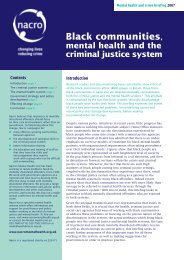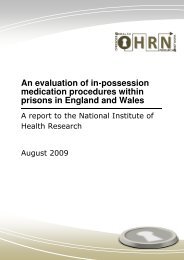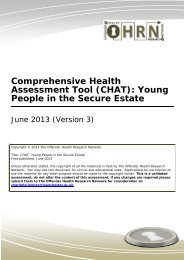Chapter Five:<strong>Justice</strong> Needs WomenWomen as Workers in the Criminal <strong>Justice</strong> SystemWe want progress, real progress that we can believe in.Any progress also has <strong>to</strong> be maintained. <strong>The</strong> flow maystart as a trickle, but it must become a regular stream. 188(Lady <strong>Justice</strong> Arden DBE, Address <strong>to</strong> the Association ofWomen Barristers, 3 June 2008)Gender exists as one of the main cleavages of inequalitywithin all societies. Yet, gender is an inequality that is so‘normal’ that it often goes unexamined. <strong>The</strong> structuralinequalities that exist between men and women manifestthemselves in relationships of power which result in womenhaving less access <strong>to</strong>, or control over, resources and lessopportunity <strong>to</strong> participate in decision making processes.<strong>The</strong> criminal justice system is no different; with womenmaking inroads at the lower levels of each of the criminaljustice agencies but with the higher positions remainingstrongly male dominated. This dominance of men in thecriminal justice arena leads <strong>to</strong> men defining ‘the rules of thegame’ so that responses <strong>to</strong> female victims and offenderswithin the justice system and the law itself remain based onmale norms and values.<strong>The</strong> GED was seen as having the potential <strong>to</strong> transformthe criminal justice sec<strong>to</strong>r for staff working within thesystem, with employers across the criminal justice systemrequired <strong>to</strong> undertake initiatives <strong>to</strong> encourage women, andin particular ethnic minority women, <strong>to</strong> move in<strong>to</strong> areas ofthe system where women are underrepresented. However,the Commission has found results disappointing <strong>to</strong> date.<strong>The</strong>re has been some good policy development, such asthe development of gender equality schemes. However,in practice, the numbers of women within criminal justiceagencies in senior positions have only marginally improvedover the last five years.<strong>The</strong>refore, while there is growing acknowledgement thatfemale victims and female offenders require a justicesystem that is responsive <strong>to</strong> their distinct needs, there isless recognition that justice needs women, with a greaterrepresentation of women, particularly in high level positions,crucial <strong>to</strong> make a gender responsive criminal justice systema reality. <strong>The</strong> idea of the involvement of women as central <strong>to</strong>justice is not a new concept. Interestingly, representationsof justice in the western tradition have typically taken thefemale form. Since the time of the ancient Greeks, the“<strong>Justice</strong> Ideal” has been depicted as a woman, usuallydraped in flowing robes, with a sword in her right hand andscales in her left and sometimes wearing a blindfold. 189 <strong>The</strong>“idea” of justice has come <strong>to</strong> be identified with this image.<strong>The</strong>re has been much debate as <strong>to</strong> why the participationof women in the justice sec<strong>to</strong>r and the promotion of therights, skills and experiences of women is important. Wedo not propose <strong>to</strong> explore these arguments in depth butwe do wish <strong>to</strong> highlight three central premises. Firstly,women make up half of the population of the UnitedKingdom and as such should be fairly represented withinhigh level decision-making roles within the justice sec<strong>to</strong>r.This is stipulated in Article 7 of CEDAW which provides forthe elimination of discrimination against women in publicand political life and in both CEDAW and the InternationalCovenant on Civil and Political Rights which statesthat women shall enjoy “human rights and fundamentalfreedoms on a basis of equality with men.” 190 As onefemale judge <strong>to</strong>ld the Commission:I think it is important for women <strong>to</strong> be seen in all areasof the criminal justice system. Until this is true the systemis not reflective of society. I do not believe that there is adifference in the administration of justice because thereare women doing the job but that is an argument forwomen <strong>to</strong> do the job not <strong>to</strong> the contrary. 191Secondly, justice needs <strong>to</strong> be responsive and accessible<strong>to</strong> all citizens, irrespective of gender. <strong>The</strong> suspects,defendants, offenders, victims and witnesses interactingwith the criminal justice system, are all of diversebackgrounds –across gender, class, race, religion, disabilityand sexual orientation. It is therefore important that thesenior staff within criminal justice agencies are equallydiverse so that the system is perceived as relevant andresponsive. <strong>The</strong> increased participation of women withinthe criminal justice sphere is also important in breakingdown gender roles more generally, as the increasedvisibility of women in senior positions and the emergence offemale role models can re-shape gender role expectationsand may also contribute <strong>to</strong> a decrease in gender-basedviolence.Thirdly, women’s experiences of the justice system andof everyday life, frequently differ <strong>from</strong> those of men. <strong>The</strong>participation of women within criminal justice agencies istherefore crucial in order <strong>to</strong> ensure understanding of thePage 66
different needs and experiences of women and <strong>to</strong> bringdifferent perspectives and approaches <strong>to</strong> issues.However, <strong>to</strong>ken inclusion of women within senior positionsis likely <strong>to</strong> have little impact. Research suggests that a‘critical mass’ of women is needed in order <strong>to</strong> challengeexisting practices. For example, in Sweden, when womenmade up only 15 percent of the parliament they tended<strong>to</strong> behave more like the male members of parliament.Conversely, as their numbers increased <strong>to</strong> 45 percent,women began <strong>to</strong> advocate for changes important <strong>to</strong>Swedish women and insisted that men take on socialwelfare responsibilities. 192 Arguably, therefore, achievinggender balance is necessary for any substantial change inapproaches <strong>to</strong> justice.Whether gender balance can be achieved, particularlyin senior levels, will depend on how responsive careerprogression and grading practices are <strong>to</strong> the needs ofwomen and how workplaces adapt <strong>to</strong> utilise the skillsand experiences of women. Adopting a gender neutralapproach, which ensures the ‘playing field remains thesame’ is not a solution. Rather, the participation of womenshould be unders<strong>to</strong>od as a route <strong>to</strong> challenging maledominance.<strong>The</strong> experiences shared with the Commission by the manywomen working in the criminal justice sec<strong>to</strong>r reveal thatsystematic discrimination and the male dominated cultureof the criminal justice agencies are still a major concern. Weexamine each of the agencies in turn.<strong>The</strong> PoliceEven in 2008 I have had very little experience of femaleofficers being treated equally once they choose <strong>to</strong>have a family. <strong>The</strong> senior management make things souncomfortable they are forced in<strong>to</strong> a corner. 193<strong>The</strong> proportion of women at senior levels in the policecontinues <strong>to</strong> be disappointing. As the table belowdemonstrates, in 2008, 34,404 of the 142,364 officerswere women (24 percent) and at Chief Inspec<strong>to</strong>r gradeand above 12 percent were women whilst 27 percent ofconstables were female. 194Table Three – Police Officer Ranks by Gender (31 March 2008)Police Numbers PercentagesMale Female Total Male Female TotalConstables 79,658 29,390 109,048 73 27 100Sergeants 18,779 3,569 22,348 84 16 100Inspec<strong>to</strong>r 6,262 982 7,244 86 14 100Chief Inspec<strong>to</strong>r 1,672 263 1,935 86 14 100Superintendent 954 113 1,067 89 11 100Chief Superintendent 455 58 513 89 11 100ACPO ranks 180 29 209 86 14 100Total 107,960 34,404 142,364 76 24 100Page 67





